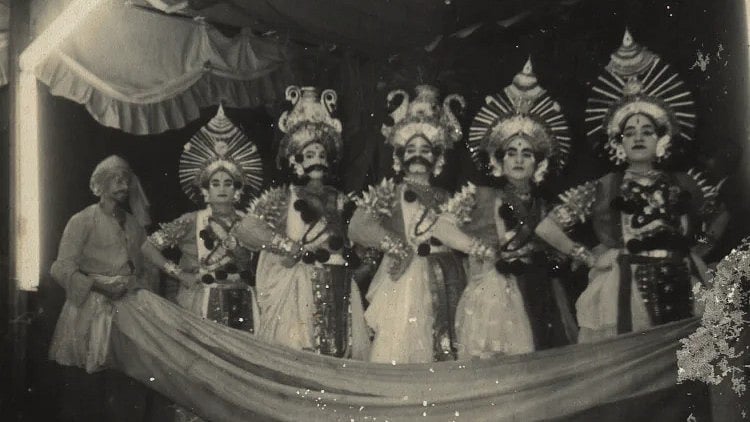
Credit: Special Arrangement
It began with the entry of Kaurava from a corner of the stage, tightly gripping the mace in one arm, and moving his other trembling arm to indicate the mortal remains of the mighty army, including his family members, in the Kuruskshetra battle. The scene received thundering applause from the audience whenever Keremane Shivaram Hegde performed the role of Kaurava in 'Gadaparva', an episode of an all-night Yakshagana show. His eyes, full of complex emotions, recalling the past glory and present sorrow of Duryodhana, used to send chills down the spines of the audience. The mellowing song, 'Kururayanidanella Kandu Santapadi' of the Bhagavata used to add to the vivid imagery.
Such an innovative entry was just one example of how Shivaram Hegde used to bring an epic episode to life, not just through pensive acting in the typical Uttara Kannada style, but also through thoughtful experiments without violating the traditional framework of Yakshagana. His Kaurava and other roles have influenced several artistes of the next generations. The stalwart's impressive performance was a harmonious blend of dance, mudras (hand gestures), eye movements, expression of emotions and dialogue. This multidimensional depiction of different characters has remained in the memory of Yakshagana lovers.
A traditional Kannada theatre form, Yakshagana is popular in the coastal and Malnad regions, traditionally presenting Puranic episodes through a unique combination of music, dance, costume, acting and dialogue. A ‘mela’ is typically a professional Yakshagana troupe which stages shows at different places every day throughout the season.
Shivaram Hegde formed the Shri Idagunji Mahaganapati Yakshagana Mandali, popularly known as Keremane Mela in Gunavante village in Honnavar taluk of Uttara Kannada district in 1934. This 90-year-old mela has the credit of nurturing three national award-winners, who received the Central Sangeet Natak Akademi award — Keremane Shivaram Hegde, Keremane Shambhu Hegde and Keremane Mahabala Hegde.
Keremane Shambhu Hegde, Shivaram’s son, revived the troupe in the 1970s. At this time, experiments like a semi-circular stage and changes in ornaments became common. Today, they are being followed by other troupes. He also has the credit of adapting choreography without disturbing the traditional style of Yakshagana, after being trained by Maya Rao at the Natya Institute of Kathak and Choreography in New Delhi, and observing other traditional Indian dance forms.
Keremane Mela stopped daily touring performances and started performing only on invitation since the mid-1980s. Their focus was on limited-time performances, spreading Yakshagana to non-Yakshagana areas, and systematically teaching this vibrant dance-drama in the typical Uttara Kannada style. Amid several challenges, financial constraints and competition by commercial troupes, Shambhu Hegde was known for his discipline in maintaining tradition, along with experimentation. He was also renowned for characters like Rama, Harishchandra, Krishna and other roles. The mela also has the fame of becoming the first professional Yakshagana troupe to perform abroad.
Keremane Mahabala Hegde, Shivaram Hegde’s nephew, was also one of the all-time greats in Yakshagana. He worked with Shivaram Karanth. Shambhu's brother, Keremane Gajanan Hegde, was known for his depiction of female characters.
From past to present
Today, Keremane Mela is led by Shambhu Hegde's son, Keremane Shivanand Hegde. It has spread its activities further, aiming to enrich Yakshagana with experiments with choreography, training and interaction with different art forms. Education, preservation and promotion of Yakshagana are its main objectives.
Keremane Mela is unique in its focus on training, workshops and demonstration of the Uttara Kannada style of Yakshagana. Recently, the Idagunji Mandali was honoured with global recognition from UNESCO, becoming the first Yakshagana institution to achieve this distinction of being classified as a piece of intangible cultural heritage.
According to Keremane Shivanand Hegde, who is also the director and choreographer of the mela, the specialty of the troupe is to not glorify or undermine any element or role of Yakshagana, but to have a balance of value-addition without disturbing the tradition.
The Mandali has been organising a Rashtriya Natyotsav in honour of Shambhu Hegde for the past 15 years. At the event, awards are presented to achievers from different arts, and various performances are organised.
“At Kalakendra, our training institute, we conduct bi-weekly classes at five schools in nearby villages and arrange a performance by those students annually. For non-Yakshagana artistes from different parts of the country, we also conduct a month-long free Yakshagana training camp," Shivanand says.
He laments the fact that Kalakendra is the only such centre in the district, but not being able to offer regular training due to uncertainty in government grants now is a threat to the continuation of the Uttara Kannada style or the Badabadagu Tittu tradition, he adds.
Many among today's popular artistes had learnt at this Kalakendra. Shivanand's son, Shridhar, is a sixth-generation artiste of the Keremane family.
Widespread influence
According to Yakshagana scholar Dr M Prabhakar Joshi, Keremane Mela is like a movement, comparable to the work of Shivaram Karanth in Yakshagana and K V Subbanna in theatre. "It has shown how a professional troupe can maintain traditional stylistic purity and quality, and is a model for bringing newness without compromising with the framework of the Yakshagana," he says.
For Karnataka Yakshagana Academy Former Chairman G L Hegde, Keremane Mela is the representative Yakshagana troupe of the Uttara Kannada district, and the influence of stalwarts of this troupe can still be seen in many artistes today.
“Shivaram Hegde was a born artiste and nobody predicted which song he would select to perform extraordinarily. Innovating and balancing all elements, resulting in a comprehensive performance was Shambhu Hegde's greatness," he adds.